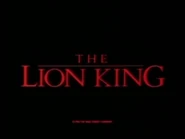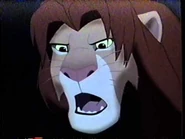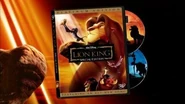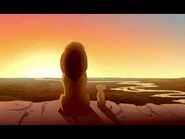First Disney Animated Movie Not Based on an Existing Story
-
This article is about the 1994 traditionally animated film. For the 2019 photorealistic computer-animated film of the same name, see The Lion King (2019 film).
- "The greatest adventure of all is finding our place in the circle of life."
- ―Tagline
The Lion King is an animated, musical/drama feature film produced by Walt Disney Feature Animation as the 32nd film in the Disney Animated Canon. Containing elements of Hamlet and Macbeth by William Shakespeare, the story centers a lion prince named Simba, who must overcome the loss of his father and his villainous uncle, Scar, in order to take his rightful place as the king of the Pride Lands.
The Lion King received universal acclaim from critics, who praised the film for its music, animation, story, and the performances of the voice cast. During its release in 1994, the film grossed more than $763 million worldwide, making it the most successful film released that year, beating Forrest Gump, True Lies, The Mask, and Speed. Today, The Lion King holds the record as the highest-grossing traditionally animated film in history. Its success solidified what was regarded as the Disney Renaissance. It also became the second highest-grossing animated film after Aladdin.
The Lion King was followed by two movies: a sequel, The Lion King II: Simba's Pride; and a part prequel-part parallel, The Lion King 1½. Additional spin-offs include the television series Timon & Pumbaa and The Lion Guard. In 2019, a theatrical remake of the film was released using photo-realistic computer animation to portray the characters and environments.
In 2016, the film was chosen for preservation by the United States National Film Registry by the Library of Congress as being "culturally, historically, or aesthetically significant".[1]
Contents
- 1 Plot
- 2 Voice cast
- 2.1 Additional voices
- 3 Development
- 4 Music
- 5 Release
- 5.1 Masterpiece Edition
- 5.2 Platinum Edition
- 5.3 Diamond Edition
- 5.4 Signature Collection
- 6 Videos
- 6.1 Signature Edition Videos
- 7 Gallery
- 8 Trivia
- 9 References
- 10 External links
Plot
The story of The Lion King takes place in an African kingdom called the Pride Lands, where a lion rules over the other animals as king.
Rafiki, a mandrill shaman, anoints Simba, the newborn cub of King Mufasa and Queen Sarabi, and presents him to a gathering of animals at Pride Rock. Meanwhile, Mufasa's younger brother, Scar, who decided not to be at the ceremony, is annoyed that he is no longer the heir to the throne. Mufasa confronts Scar about not attending the ceremony and says to not turn his back on him when he tries to leave. When Scar says Mufasa should not turn his back on him and Mufasa asks him if it is a challenge, Scar replies that he would not dream of it as he lacks brute strength. After Scar leaves, Mufasa wonders what to do with him.
A few years later, Mufasa shows a young Simba the Pride Lands and explains to him the responsibilities of kingship and the "circle of life", which connects all living things. Meanwhile, Scar plots to eliminate Mufasa and Simba so he may become king. He tricks Simba and his best friend Nala into exploring a forbidden elephant graveyard, where the cubs are chased by three hyenas named Shenzi, Banzai, and Ed, who are in league with Scar. Mufasa is alerted of the incident by Zazu and rescues the cubs. Though disappointed in Simba, Mufasa eventually forgives him and explains that the great kings of the past watch over them from the night sky, from which he will one day watch over Simba.
Later that night, Scar gains the loyalty of the hyenas by claiming that if he becomes king, they will "never go hungry again" if they help him kill Mufasa and Simba. Plotting further, Scar gathers more hyenas forming an army. Sometime later, Scar lures Simba into a gorge for a "surprise from his father" then signals the hyenas to create a wildebeest stampede down into the gorge where Simba is. Alerted by an insincerely dramatic Scar, Mufasa races to rescue Simba from the stampede. He saves his son but is left clinging to the edge of a cliff, which results in Scar flinging him into the stampede below to his death. Scar convinces Simba that he was responsible for his own father's death and recommends that he flees the Pride Lands, never to return. To compound this, Scar once again sends the hyenas to kill Simba, but as Simba reaches a thorny embankment, they let him escape, hurling threats that he will be killed if ever seen again. That night back at Pride Rock, Scar informs Sarabi, Nala, and the rest of the pride that both Mufasa and Simba were killed in the stampede and that he is assuming the throne as the closest of kin. After becoming king, Scar fulfills his promise to the hyenas and allows them to come into the Pride Lands.
Simba collapses in a distant desert where he is found unconscious by Timon and Pumbaa, a meerkat-warthog duo who raise Simba under their carefree "Hakuna Matata" lifestyle. When Simba has grown into a young adult, he saves them from a hungry lioness revealed to be Nala. Simba shows Nala around his home, and the two begin to fall in love. Nala then tells him that Scar's tyrannical reign has turned the Pride Lands into a barren wasteland; she demands that Simba return and take his rightful place as king, but Simba refuses, still guilty about supposedly causing his father's death. Rafiki arrives and persuades Simba to return to the Pride Lands, assisted by Mufasa's presence in the stars. After some advice from Rafiki and the ghost of his father, Simba, followed by Nala, Timon, and Pumbaa, returns home.
Once back at Pride Rock, Simba (with Timon, Pumbaa, and Nala) is horrified to see the condition of the Pride Lands. What was once a lush paradise was now a dead wasteland. With the overhunting, the prey eventually left the Pride Lands, causing famine in the pride. After seeing Scar strike his mother, Simba announces his return. In response, Simba confronts Scar, who forces Simba to confess to being responsible for Mufasa's death. Scar then forces Simba over the edge of Pride Rock, just as a lightning bolt starts a fire below. As Simba dangles over the edge of Pride Rock, Scar whispers to Simba that he killed Mufasa. Enraged, Simba leaps up and pins Scar to the ground, forcing him to admit the truth to the pride. A raging battle ensues between the hyenas and the lionesses, Timon, and Pumbaa, which results in Simba cornering Scar. Amid their fight, Scar tries to surreptitiously blame everything on the hyenas, but the hyenas overhear his conversation with Simba and back away growling. Simba orders Scar to flee the Pride Lands. Scar pretends to leave but turns to attack Simba, resulting in a final duel. Simba eventually overpowers Scar by kicking and hurling him over a low cliff. Scar initially survives the fall but finds himself surrounded by the now resentful hyenas. The hyenas surround their traitorous fallen leader. Scar frantically tries to absolve himself, but the hyenas finally had enough of his lies, derogatory treatment, and violated promises, so they ignore his life plea, attack him, and maul him to death, as flames rise around and engulf them.
With Scar and the hyenas gone, the rightful king in place, and the Pride Lands restored, turning green with life again, Rafiki presents Simba and Nala's newborn cub into the air, thus continuing the Circle of Life.
Voice cast
- Simba (voiced by Jonathan Taylor Thomas as a cub and Matthew Broderick as an adult) is the son of King Mufasa and Queen Sarabi and destined to be king and the main protagonist. His singing voices are Jason Weaver as a cub and Joseph Williams as an adult.
- Nala (voiced by Niketa Calame as a cub and Moira Kelly as an adult) is the daughter of Sarafina and the best friend of Simba and the deuteragonist of the film. Her singing voices are Laura Williams as a cub and Sally Dworsky as an adult.
- Scar (voiced by Jeremy Irons) is the younger brother of King Mufasa and the uncle of the future king Simba. He is shown to be extremely jealous of his brother and desperately wanting to be king. His singing voice is by Jeremy Irons, though for some lines of "Be Prepared", he is voiced by Jim Cummings.
- Mufasa (voiced by James Earl Jones) is the mate of Queen Sarabi, the brother of Scar and the father of Simba and is the King of the Pride Lands. He is shown after his death to continue to live on in spirit, still able to communicate.
- Timon and Pumbaa (voiced by Nathan Lane and Ernie Sabella respectively) are a meerkat and warthog duo and are shown to follow a problem free philosophy called "Hakuna Matata" which they teach on Simba once they took him in.
- Zazu (voiced by Rowan Atkinson) is the majordomo of King Mufasa and was often the babysitter of young Prince Simba and his friend Nala. During Scar's reign, he was imprisoned and forced to sing for Scar.
- Rafiki (voiced by Robert Guillaume) is a wise mandrill and shaman and a close friend of King Mufasa. He is shown presenting the King's young son Simba to the Pridelanders.
- Sarabi (voiced by Madge Sinclair) is the mate of Mufasa, the mother of Simba and the Queen of the Pride Lands and is shown to be kind caring yet outspoken for rightness.
- Shenzi, Banzai, and Ed (voiced by Whoopi Goldberg, Cheech Marin, and Jim Cummings respectively) are a trio of hyenas who live in the Outlands and vend for themselves and are great enemies of the Pride Lands though the jealous Scar is a secret ally with them.
- Sarafina (voiced by Zoe Leader) is the mother of Nala and a close friend of Sarabi.
- Gopher (voiced by Jim Cummings) is the gopher assistant of Zazu.
Additional voices
- Frank Welker
- Cathy Cavadini
- Judi Durand
- Daamen Krall
- David McCharen
- Linda Phillips
- Phil Proctor
- David Randolph
Development
The idea for The Lion King was conceived in late 1988 during a conversation between Jeffrey Katzenberg, Roy E. Disney, and Peter Schneider on a plane to Europe to promote Oliver & Company. During the conversation, the topic of a story set in Africa came up, and Katzenberg immediately jumped at the idea.[2] Producer Thomas Schumacher, who had just completed The Rescuers Down Under, decided to attach himself to the project "because lions are cool". The idea was then developed by Walt Disney Feature Animation's vice president for creative affairs Charlie Fink.[3] Katzenberg decided to add elements involving coming of age and death,[4] and ideas from personal life experiences, such as some of his trials in his bumpy road in politics, saying about the film, "It is a little bit about myself."[4] In November of that year Thomas Disch (author of The Brave Little Toaster) wrote a treatment entitled King of the Kalahari,[5] and afterwards Linda Woolverton spent a year writing drafts of the script, which was titled King of the Beasts and then King of the Jungle.[3] The original version of the film was very different from the final film. The plot was centered in a battle being between lions and baboons with Scar being the leader of the baboons, Rafiki being a cheetah,[4] and Timon and Pumbaa being Simba's childhood friends. Simba would also not leave the kingdom, but become a "lazy, slovenly, horrible character" due to manipulations from Scar, so Simba could be overthrown after coming of age.[3]
Oliver & Company director George Scribner was the initial director of the film, being later joined by Roger Allers, who was the lead story man on Beauty and the Beast in October 1991.[2] Allers brought with him Brenda Chapman, who would become the head of the story.[3] Afterwards, several of the lead crew members, including Allers, Scribner, Hahn, Chapman, and production designer Chris Sanders, took a trip to Hell's Gate National Park in Kenya, in order to study and gain an appreciation of the environment for the film.[7] After six months of story development work Scribner decided to leave the project, as he clashed with Allers and the producers on their decision to turn the film into a musical, as Scribner's intention was of making a documentary-like film more focused on natural aspects.[2] [8] Rob Minkoff replaced Scribner, and producer Don Hahn joined the production. Hahn found the script unfocused and lacking a clear theme, and after establishing the main theme as "leaving childhood and facing up to the realities of the world", asked for a final retool. Allers, Minkoff, Chapman, and Hahn then rewrote the story across two weeks of meetings with directors Kirk Wise and Gary Trousdale, who had just finished Beauty and the Beast.[7] The script also had its title changed from King of the Jungle to The Lion King, as the setting was not the jungle but the Savannah.[2]
The Lion King was the first Disney animated feature to be an original story, rather than being based on an already-existing work. The filmmakers have said that the story of The Lion King was inspired by the Joseph and Moses stories from the Bible and William Shakespeare's Hamlet.[9] Despite these claims, the story was not based on the aforementioned works, having actually taken more inspiration from actual animal behavior. During the summer of 1992, the team was joined by screenwriter Irene Mecchi, with a second screenwriter, Jonathan Roberts, joining a few months later. Mecchi and Roberts took charge of the revision process, fixing unresolved emotional issues in the script and adding comic business for Pumbaa, Timon and the hyenas. Lyricist Tim Rice worked closely with the writing team, flying to California at least once a month, as his songs needed to work in the narrative continuity. Rice's lyrics – which were reworked up to the production's end – were even pinned to the storyboards during development.[7] Rewrites were frequent, with animator Andreas Deja saying that completed scenes would be delivered only for the response to be that parts needed to be reanimated due to dialog changes.[3]
The voice actors were chosen for how they fit and could add to the characters – for instance, James Earl Jones was cast because the directors found his voice "powerful" and similar to a lion's roar. Nathan Lane originally auditioned for Zazu, and Ernie Sabella for one of the hyenas. Upon meeting each other at the recording studio, the actors, who at the time both co-starred in Guys and Dolls, were asked to record together as hyenas. The directors laughed at their performance and decided to cast them as Timon and Pumbaa.[10] For the hyenas, the original intention was to reunite Cheech & Chong, but while Cheech Marin accepted to play Banzai, Tommy Chong was unavailable. Thus, his role was changed into a female hyena, Shenzi, who was voiced by Whoopi Goldberg.
The development of The Lion King started concurrently with Pocahontas, which most of the animators of Walt Disney Feature Animation decided to work on instead, believing it would be the more prestigious and successful of the two.[9] The story artists also did not have much faith in the project, with Brenda Chapman declaring she was reluctant to accept the job "because the story wasn't very good",[3] and writer Burny Mattinson saying to co-worker Joe Ranft about the film that "I don't know who is going to want to watch that one."[8] Most of the leading animators were either doing their first major work supervising a character, or had much interest in animating an animal.[4] Thirteen of these supervising animators, both in California and Florida, were responsible for establishing the personalities and setting the tone for the film's main characters. The animation leads for the main characters included Mark Henn on young Simba, Ruben A. Aquino on adult Simba, Andreas Deja on Scar, Aaron Blaise on young Nala, Anthony DeRosa on adult Nala, and Tony Fucile on Mufasa. Nearly 20 minutes of the film, including the "I Just Can't Wait to Be King" sequence, were animated at the Disney-MGM Studios facility. Ultimately, more than 600 artists, animators, and technicians contributed to The Lion King over the course of its production. Weeks before the film was to be released, production was affected by the 1994 Northridge earthquake, which shut off the studio and required the animators to finish their work from home.[11]
The character animators studied real-life animals for reference, as was done for the 1942 Disney film Bambi. Jim Fowler, a renowned wildlife expert, visited the studios on several occasions with an assortment of lions and other savannah inhabitants to discuss behavior and help the animators give their drawings an authentic feel.[7] The Pride Lands are modeled on the Kenyan national park visited by the crew. Varied focal lengths and lenses were employed to differ from the habitual portrayal of Africa in documentaries – which employ telephoto lenses to shoot the wildlife from a distance. The epic feel drew inspiration from concept studies by artist Hans Bacher – which, following Scribner's request for realism, tried to depict effects such as lens flare – and the works of painters Charles Marion Russell, Frederic Remington, and Maxfield Parrish.[7] [12] Since the characters were not anthropomorphized in terms of posture, all the animators had to learn to draw four-legged animals, and the story and character development was done through the usage of longer shots following the characters.
The use of computers helped the filmmakers present their vision in new ways. The most notable use of computer animation is in the "wildebeest stampede" sequence. Several distinct wildebeest characters were created in a 3D computer program, multiplied into hundreds, cel-shaded to look like drawn animation, and given randomized paths down a mountainside to simulate the real, unpredictable movement of a herd. Five specially trained animators and technicians spent more than two years creating the two-and-a-half minute stampede sequence. Other usages of computer animation were done through CAPS, which helped simulate camera movements such as tracking shots, and was employed on the coloring, lighting, and particle effects.
The enthusiastic audience reception to an early Lion King film trailer, which consisted solely of the opening sequence with the song "Circle of Life", suggested that the film would be very successful. While both The Lion King and Pocahontas were commercial successes, The Lion King received more positive feedback and earned larger grosses than did Pocahontas, released one year later.[13] [14] [15]
The complex wildebeest stampede scene took nearly three years to complete.[16]
Music
- Main article: The Lion King (1994 soundtrack)
Elton John and Tim Rice wrote five original songs for this film, with Elton John performing "Can You Feel the Love Tonight" during the end credits. The film's score was composed by Hans Zimmer and supplemented with traditional African music and choir elements arranged by Lebo M.
The film's original motion picture soundtrack was released on July 13, 1994. It was the fourth best-selling album of the year on the Billboard 200 and the top-selling soundtrack.
On February 28, 1995, Disney released an album entitled Rhythm of the Pride Lands, which featured songs and performances inspired by, but not featured in, the film. Focusing on the African influences in the film's original music, most of the tracks were by African composer Lebo M, sung either partially or entirely in various African languages. Several songs included on the album would be used in other The Lion King-related projects, such as the stage musical and the direct-to-video sequels (e.g., "He Lives In You" was used as the opening song for The Lion King II: Simba's Pride, and a reincarnation of "Warthog Rhapsody", called "That's All I Need", in The Lion King 1½). Rhythm of the Pride Lands was initially issued in a very limited quantity, but there was a 2003 re-release included in some international versions of The Lion King's special edition soundtrack, with an additional track. Additionally, The Lion King Expanded Score contains never-before-released instrumental music from Hans Zimmer's original score.
Release
- Main article: The Lion King (video)
The Lion King garnered widespread critical acclaim, and at Rotten Tomatoes, based on 128 reviews collected, the film has an overall approval rating of 93%, with a weighted average score of 8.41/10. Among Rotten Tomatoes Cream of the Crop, which consists of popular and notable critics from the top newspapers, websites, television, and radio programs, the film holds an overall approval rating of 100 percent. By comparison, Metacritic, which assigns a Standard score of 0-100 rating to reviews from mainstream critics, calculated an average score of 84 from the 13 reviews it collected.
Masterpiece Edition
The Lion King was first released on VHS and laserdisc in the United States on March 3, 1995, under Disney's "Masterpiece Collection" video series. In addition, Deluxe Editions of both formats were released. The VHS Deluxe Edition included the film, an exclusive lithograph of Rafiki and Simba (in some editions), a commemorative "Circle of Life" epigraph, six concept art lithographs, another tape with the half-hour TV show The Making of The Lion King, and a certificate of authenticity. The CAV laserdisc Deluxe Edition also contained the film, six concept art lithographs and The Making of The Lion King, and added storyboards, character design artwork, concept art, rough animation, and a directors' commentary that the VHS edition did not have, on a total of four double-sided disks. The VHS tape quickly became one of the best-selling videotapes of all time: 4.5 million tapes were sold on the first day and ultimately sales totaled more than 30 million before these home video versions went into moratorium in 1997.
Platinum Edition
On October 7, 2003, the film was re-released on VHS for the second time and released on DVD for the first time, titled The Lion King: Platinum Edition, as part of Disney's Platinum Edition line of animated classic DVDs. The DVD release featured two versions of the film on the first disc, a remastered version created for the 2002 IMAX release of the film in both forms: the "Special Edition" cut with a musical number added and the "Original Theatrical Release" cut. A second disc, with bonus features, was also included in the DVD release. The film's soundtrack was provided both in its original Dolby 5.1 track and in a new Disney Enhanced Home Theater Mix, making this one of the first Disney DVDs so equipped. By means of seamless branching, the film could be viewed either with or without a newly-created scene — a short conversation in the film replaced with a complete song ("The Morning Report"). A Special Collector's Gift Set was also released, containing the DVD set, five exclusive lithographed character portraits (new sketches created and signed by the original character animators), and an introductory book entitled The Journey.
The Platinum Edition of The Lion King was criticized by fans for its false advertising: producer Don Hahn had earlier stated that the film would be in its original 1994 theatrical version, but it was confirmed after release that it was the "digitally enhanced" IMAX version instead, which is slightly different from the original theatrical cut. One of the most noticeable differences is the re-drawn crocodiles in the "I Just Can't Wait to Be King" sequence. Despite this criticism, more than two million copies of the Platinum Edition DVD and VHS units were sold on the first day of release. A DVD boxed set of the three The Lion King films (in two-disc Special Edition formats) was released on December 7, 2004. In January 2008, the film, along with the sequels, went back into the moratorium, but new and used copies still sell very well.
Diamond Edition
Prior to announcing the Diamond Edition release of the film, Disney showed clips of the film on Blu-ray at the Consumer Electronics Show 2008. Disney announced in the Beauty and the Beast: Diamond Edition official site, that The Lion King was released in a Diamond Edition Blu-ray/DVD combo pack on October 4, 2011. Also, on October 4, 2011, The Lion King was released for the very first time on Blu-ray Disc. As well as being released as a Blu-ray/DVD combo pack and a stand-alone DVD Edition like the previous Diamond Edition releases, The Lion King was the first to be released in a Disney 3D Blu-ray combo pack. This is the second Disney 3D combo pack, following Tangled earlier in the year. There is a Trilogy Collector's set, it has The Lion King: Diamond Edition Blu-ray 3D + Blu-ray + DVD + Digital Copy, The Lion King 1 ½: Blu-ray + DVD, and The Lion King 2: Blu-ray + DVD. The Lion King was released on DVD for the second time and was also the first Diamond Edition title to include a 1-Disc DVD Edition instead of a 2-Disc DVD set like previous Diamond titles, which became available on November 15, 2011. It went back into moratorium along with Lady and the Tramp on April 30, 2013.
Signature Collection
The film became available on Digital HD August 15, 2017, and on Blu-ray/DVD August 29, 2017. It later got a 4K Ultra HD release on December 4, 2018.
Videos

The Lion King - Sneak Peek (from Aladdin 1993 VHS)
1993 Sneak Peek Trailer

The Lion King - Sneak Peek (from The Fox & the Hound 1994 VHS)
1994 Sneak Peek Trailer

The Lion King - 1994 Theatrical Trailer-2
1994 Theatrical Trailer

The Lion King (1994) Teaser (VHS Capture)-2
Home Video Trailer

The Lion King - 2002 IMAX Trailer-2
2002 IMAX Trailer

The Lion King (Platinum Edition) 2003 DVD Trailer
2003 Platinum Edition Trailer

The Lion King - Platinum Edition DVD Trailer 2
2003 Platinum Edition Trailer 2

The Lion King 2011 - Blu-ray Trailer-HQ--2
2011 Diamond Edition Trailer

The Lion King 3D Trailer -2011 NEW--2
3D Re-release Trailer
Signature Edition Videos

The Lion King Trailer

The Lion King Inside The Story Room

The Lion King Circle of Life Montage

The Lion King Visualizing A Villain

The Lion King The Circle Of Life

The Lion King Disney Junior

The Lion King Hakuna Matata

The Lion King Oh I Just Can't Wait To Be King

The Lion King Can You Feel The Love Tonight

The Lion King - 98° "Circle of Life" Behind the Scenes
Gallery

Trivia
- There is a considerable controversy of plagiarism of the 1965 Japanese animation "Kimba the White Lion" in regard to similar plots, character design and personalities, animation sequences, and other examples. However, in recent events, the plagiarism accusations were debunked.
- The film would currently be the 19th highest-grossing animated film of all time worldwide if it had never been re-released.
- At the end of the film, Simba and Nala's newborn cub is presented to the Pride Lands by Rafiki. In 1995, a commentary track for the film was released, in which the filmmakers gave the cub the placeholder name of "Fluffy", making no gender reference at all. This all lead back to how Pocahontas, a film made around the same time as The Lion King, and released a year after the film, was expected to be the more successful movie between the two films, and thus no sequels, spin-offs, or reboots were planned ahead.
- This is the first Disney film whose title not only is near or at the beginning of the movie but at the end (before the credits), more being Tarzan, Brother Bear, and Raya and the Last Dragon.
- The film is one of Disney's first attempts at animating hair and fur, due to getting its technology to create fur.
- The Lion King was the first-ever feature film to be translated to European Portuguese and the first Disney film to be dubbed in Zulu.
- This is the second film in which James Earl Jones and Madge Sinclair appear as king and queen, and the parents of the protagonist, the first being in an R-rated live-action movie Coming to America.
- The film and its direct-to-video sequel are the first Disney animated features from the 'Disney Renaissance' era to have absolutely no humans in the movie.
- In fact, The Lion King is the first (and third overall) film in the Disney Animated Canon to have an entirely non-human cast since Robin Hood in 1973.
- Several lionesses with the same type of fur coloring as Nala appear when they battle for the last time.
- Obviously over thousands of storyboard pages were created for The Lion King. Most Disney films have over 12,000 storyboards and 10,000 storyboards. However, it took one and a half years to storyboard, and it's possible how Disney made too many storyboards for its films.
- Even though the setting is definitely Africa, there are some minor anomalies in the selection of animal species portrayed in the movie. In the "circle of life" sequence, leaf-cutter ants are seen crawling on a branch, even though leaf cutter ants are not only found in South America, they are endemic there. Also, Timon is a meerkat, and they are found in parts of Namibia and throughout South Africa, miles from Hell's Gate National Park where the main setting of the film is heavily modeled.
- In early versions of the script, Simba would have been much more vicious and had the willingness to kill, as well as Scar, being a rouge lion leading a pack of vicious baboons. The hyenas would be led by a rogue male called Banagi, who Simba would throw off Pride Rock, after killing Scar in the same way.
- Jeremy Irons and Ernie Sabella both share the same birthday: September 19; Sabella was born on Irons's first birthday.
- Also sharing another birthday are Tim Rice (the lyricist) and Niketa Calame-Harris (the speaking voice of Young Nala): November 10th. Calame had been born on Rice's 36th birthday.
- Carmen Twillie (the female soloist for "Circle of Life" at the beginning) was Whoopi Goldberg's (Shenzi) singing double as the villainess Stormella from the Christmas movie Rudolph the Red-Nosed Reindeer: The Movie.
- Although this movie is rated G by the MPAA, it received a TV-PG rating on most TV channels for the violent content, especially the scene where Mufasa dies.
- Both Nathan Lane and Ernie Sabella would later co-star together again in the 1997 film Mouse Hunt.
- Nathan Lane and Matthew Broderick would later co-star in 2001 musical The Producers and its 2005 film adaptation.
- Interestingly, speaking of the film, Ernie Sabella appeared in a deleted scene from the movie.
- Nathan Lane and Matthew Broderick would later co-star in 2001 musical The Producers and its 2005 film adaptation.
- Lyricist Tim Rice discusses working on the film in his podcast Get Onto My Cloud.
- The Lion King is referenced in the Warner Bros. movie Teen Titans Go! To the Movies. When Robin goes to bed after failing to stop Slade, he dreams that many superheroes from the Justice League are being called by Batman to see his new sidekick Robin in a similar way to how Mufasa called all the animals to see his newborn son Simba. However, rather than celebrating, the superheroes jeer at the idea of having a sidekick, leading Batman to drop Robin. Additionally, Aquaman is seen eating grass like the gazelles did, and the Batman logo is used in replacement for the rising sun.
- The film won two Academy Awards for Best Original Song and Best Original Score
References
- ↑ http://deadline.com/2016/12/national-film-registry-2016-list-thelma-louise-princess-bride-lion-king-1201870406/
- ↑ 2.0 2.1 2.2 2.3 'The Lion King: A Memoir – Don Hahn. [Blu-ray]. The Lion King: Diamond Edition: Walt Disney Home Entertainment.
- ↑ 3.0 3.1 3.2 3.3 3.4 3.5 Neuwirth, Allan. Makin' toons: inside the most popular animated TV shows and movies. Skyhorse Publishing Inc.. ISBN 978-1-58115-269-2.
- ↑ 4.0 4.1 4.2 4.3 The Pride of the King. [Blu-ray]. The Lion King: Diamond Edition: Walt Disney Home Entertainment.
- ↑ "THE ORIGINS OF THE LION KING". James Cummins Book Seller.
- ↑ 7.0 7.1 7.2 7.3 7.4 Finch, Christopher. "Afterword", The art of The Lion King . Hyperion, page 165–193. ISBN 978-0-7868-6028-9.
- ↑ 8.0 8.1 Norman, Floyd. in Ghez, Didier: Walt's People -, Volume 9. Xlibris Corporation, page 463–464. ISBN 978-1-4500-8746-9.
- ↑ 9.0 9.1 'The Lion King: Platinum Edition (Disc 2), Origins.. Walt Disney Home Entertainment.
- ↑ King, Susan. "As Lion King goes 3-D, cast and filmmakers recall making", The Los Angeles Times.
- ↑ Shirey, Eric. "Producer Don Hahn Shares His Experiences Working on The Lion King". Yahoo!.
- ↑ 2007, Hans P.. Dream worlds: production design for animation. Focal Press, page 66. ISBN 0-240-52093-9.
- ↑ "Pocahontas revenue". Box Office Mojo.
- ↑ "Rotten Tomatoes – The Lion King". Rotten Tomatoes.
- ↑ "Rotten Tomatoes – Pocahontas". Rotten Tomatoes.
- ↑ http://www.imdb.com/title/tt0110357/trivia?ref_=tt_ql_2
External links
| v - e - d | ||||||||||||||
|---|---|---|---|---|---|---|---|---|---|---|---|---|---|---|
|
| v - e - d | ||||||||||||||
|---|---|---|---|---|---|---|---|---|---|---|---|---|---|---|
|
First Disney Animated Movie Not Based on an Existing Story
Source: https://disney.fandom.com/wiki/The_Lion_King


0 Response to "First Disney Animated Movie Not Based on an Existing Story"
Post a Comment